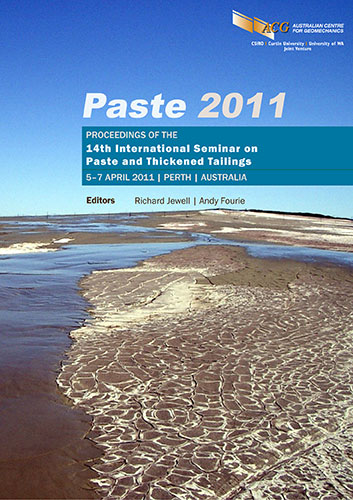The rheology and flow behaviour of fly ash and brine paste slurries

|
Authors: Maree, Y; Moolman, PL; van Sittert, FP; Paterson, AJC Paper is not available for download Contact Us |
DOI https://doi.org/10.36487/ACG_rep/1104_17_Maree
Cite As:
Maree, Y, Moolman, PL, van Sittert, FP & Paterson, AJC 2011, 'The rheology and flow behaviour of fly ash and brine paste slurries', in R Jewell & AB Fourie (eds), Paste 2011: Proceedings of the 14th International Seminar on Paste and Thickened Tailings, Australian Centre for Geomechanics, Perth, pp. 175-184, https://doi.org/10.36487/ACG_rep/1104_17_Maree
Abstract:
Sasol Technology has been investigating the co-disposal of fly ash and brine mixtures as either a paste backfill or paste slurry. The results of previous studies have been published at several paste series seminars that showed that there are environmental benefits to dispose of the salt laden brines as a paste. This paper considers the requirements for transporting these high density viscous materials. Extensive test work was done to determine the most appropriate method of producing high concentration ash paste and measuring the flow behaviour of the different ash and brine mixtures. Conventional definitions of paste refer to materials that have high yield stresses, sometimes greater than 100 Pa, are non-segregating and have little or no bleed water. The mixtures evaluated in this study have essentially no yield stress but behave as very viscous Newtonian mixtures. The mixtures still exhibit non-segregating behaviour with little or no bleed water and can still be considered a paste, even in the absence of a significant yield stress. Flow behaviour tests were conducted during several phases of the project, and this paper compares the results of bench top viscometer tests and pipe loop tests. As the material behaves as a viscous Newtonian mixture at mass solids concentrations less than 70%, the paper shows that it is possible to obtain accurate scale up and predictable behaviour from all the measurement techniques used. The analytical techniques used and experimental data are discussed, and the scale up to large diameter pipelines is confirmed from these measurements.
References:
Aude, T.C., Derammelaere, R.H. and Wasp, E.J. (1996) Instability of laminar flow in long distance pipelines and solutions, in Proceedings Coal Utilisation and Fuel Systems 21st International Technical Conference, Clearwater, Florida, USA.
Barnes, H.A. (2000) Measuring the viscosity of large-particle (and flocculated) suspensions – a note on the necessary gap size of rotational viscometers, Journal of Non-Newtonian Fluid Mechanics, Elsevier publication, Vol. 94,
pp. 213–217.
Brown, N.P. and Heywood, N.I. (1991) Slurry handling, design of solid-liquid systems, Elsevier, London, UK.
Maree, Y., Mahlaba, J.S. and Pretorius, C. (2009) Utilising fly ash as a salt sinking medium through pasting with industrial brine, in Proceedings World Congress on Engineering (WCE 2009), Vol I, July 1–3 2009, London, U.K.
Wasp, E.J. (1999) Instability of laminar flow in long distance pipelines, in Proceedings Rheology in the Mineral Industry II, Kakuka, Hawaii, USA.
© Copyright 2025, Australian Centre for Geomechanics (ACG), The University of Western Australia. All rights reserved.
View copyright/legal information
Please direct any queries or error reports to repository-acg@uwa.edu.au
View copyright/legal information
Please direct any queries or error reports to repository-acg@uwa.edu.au